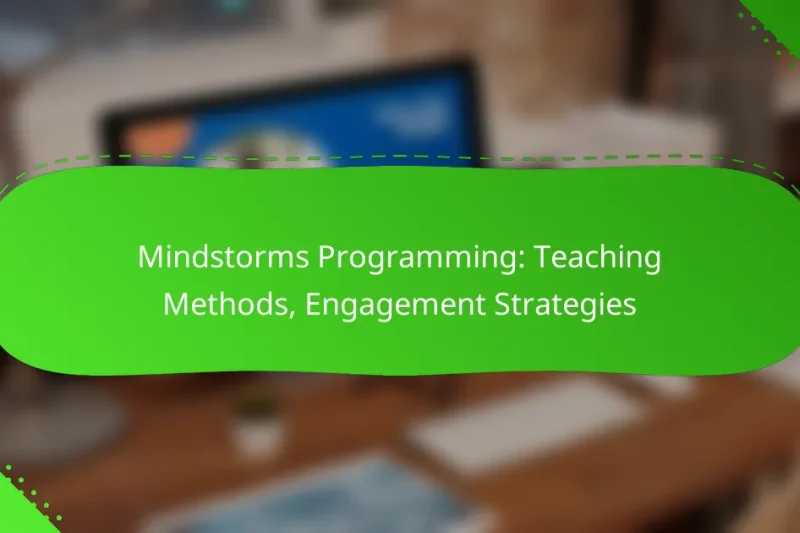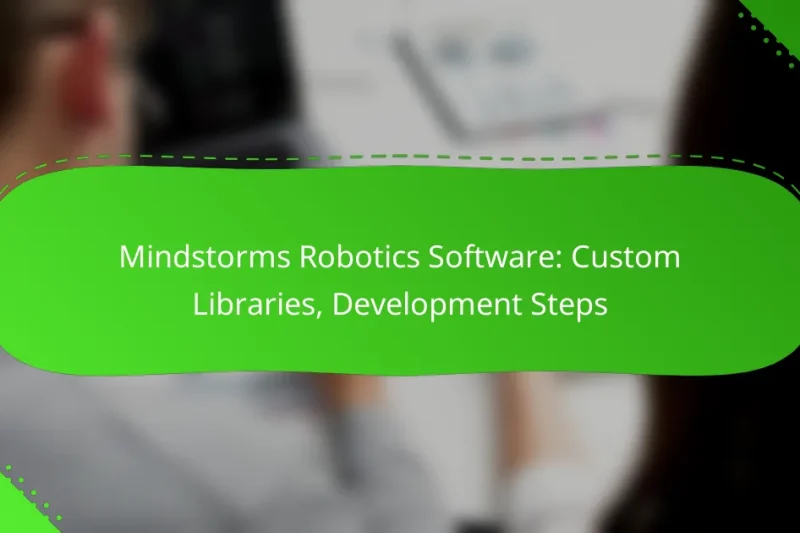In competitive robotics, mastering advanced programming techniques for Mindstorms is essential for achieving optimal performance. By … Mindstorms Programming: Advanced Techniques, Competitive RoboticsRead more
Mindstorms Robotics Software: Programming Features
Mindstorms Robotics Software offers a versatile programming environment designed for users of all skill levels, featuring both block-based and text-based programming options. With tools for real-time debugging, customizable robot behaviors, and seamless integration with various sensors and motors, it empowers users to create innovative robotic solutions. To begin, simply download the software from the official LEGO Education website and follow the installation instructions for your operating system.
Mindstorms Programming: Teaching Methods, Engagement Strategies
Mindstorms programming offers an engaging blend of creativity and technology, creating a dynamic learning environment that … Mindstorms Programming: Teaching Methods, Engagement StrategiesRead more
Mindstorms Robotics Software: Custom Libraries, Development Steps
Mindstorms Robotics Software provides a comprehensive platform for enhancing robotics development, featuring custom library support and … Mindstorms Robotics Software: Custom Libraries, Development StepsRead more
What programming features does Mindstorms Robotics Software offer?
Mindstorms Robotics Software provides a range of programming features that cater to both beginners and advanced users. These features include a block-based programming interface, text-based programming support, real-time debugging tools, customizable robot behaviors, and integration with various sensors and motors.
Block-based programming interface
The block-based programming interface allows users to create programs by dragging and dropping visual blocks that represent different commands. This user-friendly approach is ideal for beginners, as it simplifies the coding process and reduces the likelihood of syntax errors.
Users can easily connect blocks to form sequences and loops, enabling them to control robot actions intuitively. This method encourages experimentation and creativity, making it an excellent starting point for young learners.
Text-based programming support
For those with more programming experience, Mindstorms offers text-based programming support, allowing users to write code using languages like Python or Java. This feature provides greater flexibility and control over robot functions, enabling advanced users to implement complex algorithms.
Text-based programming can be particularly beneficial for projects requiring precise control or integration with external systems. Users should be familiar with programming concepts to effectively utilize this feature.
Real-time debugging tools
Mindstorms Robotics Software includes real-time debugging tools that help users identify and fix issues in their code as they develop their programs. These tools provide immediate feedback on errors, allowing for quicker troubleshooting and refinement of robot behaviors.
Debugging features may include step-by-step execution, variable monitoring, and error highlighting. Utilizing these tools can significantly enhance the learning experience and improve programming skills.
Customizable robot behaviors
Users can customize robot behaviors to suit specific tasks or challenges. This feature allows for the adjustment of movement patterns, sensor responses, and interaction with the environment, providing a tailored experience for each project.
Custom behaviors can be programmed using both block-based and text-based methods, enabling users to explore various approaches. Experimenting with different configurations can lead to innovative solutions and enhance problem-solving skills.
Integration with sensors and motors
Mindstorms Robotics Software supports seamless integration with a variety of sensors and motors, enhancing the robot’s capabilities. Users can connect sensors such as touch, color, and ultrasonic to gather data and make decisions based on environmental inputs.
Motor integration allows for precise control of movement, enabling robots to perform complex tasks. Understanding how to effectively utilize these components is crucial for maximizing the robot’s potential and achieving desired outcomes in projects.
How can I get started with Mindstorms Robotics Software?
To get started with Mindstorms Robotics Software, you need to download the application from the official LEGO Education website. Once downloaded, follow the installation instructions specific to your operating system to set up your first project.
Download from LEGO Education
You can download the Mindstorms Robotics Software directly from the LEGO Education website. Navigate to the software section, select the version that matches your LEGO Mindstorms kit, and click on the download link. Make sure to choose the correct version for your operating system to avoid compatibility issues.
Installation requirements for Windows and macOS
For Windows, ensure your system meets the minimum requirements, typically including Windows 10 or later, at least 2 GB of RAM, and a compatible processor. For macOS, the software generally requires macOS 10.12 or later, with similar RAM and processor specifications.
Before installation, check that you have sufficient disk space, usually around 1 GB, and ensure your system’s drivers are up to date. This will help prevent any installation errors and ensure smooth operation of the software.
Setting up your first project
To set up your first project, open the Mindstorms Robotics Software and select “New Project” from the main menu. You will be prompted to choose a template or start from scratch; beginners often benefit from using a template to understand the structure of a project.
Once your project is created, familiarize yourself with the interface, including the programming blocks and tools available. Start by dragging blocks into the programming area to create a simple sequence, such as moving a robot forward or turning it. Test your program frequently to troubleshoot and refine your code.
What are the system requirements for Mindstorms Robotics Software?
The Mindstorms Robotics Software has specific system requirements to ensure smooth operation. These requirements include compatible operating systems, minimum hardware specifications, and recommended configurations for optimal performance.
Supported operating systems
The Mindstorms Robotics Software is compatible with various operating systems, primarily Windows and macOS. For Windows, versions 10 and later are generally supported, while macOS users should have versions that are recent enough to support the software’s features.
It’s advisable to check the official website for the latest compatibility updates, as software updates may affect supported operating systems over time.
Minimum hardware specifications
To run the Mindstorms Robotics Software effectively, your system should meet certain minimum hardware specifications. Typically, this includes at least 4 GB of RAM, a dual-core processor, and a minimum of 2 GB of available disk space.
Graphics capabilities should support a resolution of 1280 x 800 or higher to ensure a clear interface. Meeting these minimum requirements will allow basic functionality, but performance may be limited.
Recommended configurations for optimal performance
For the best experience with Mindstorms Robotics Software, it’s recommended to use a system with at least 8 GB of RAM and a quad-core processor. This configuration will facilitate smoother operation, especially when handling complex programming tasks.
Additionally, having a dedicated graphics card can enhance visual performance, particularly when using simulation features. Ensuring ample disk space, ideally 5 GB or more, will also support software updates and additional resources.
How does Mindstorms Robotics Software compare to other programming tools?
Mindstorms Robotics Software offers a unique blend of visual programming and hardware integration, making it distinct from other programming tools. Its focus on robotics allows for hands-on learning, while other platforms may prioritize different aspects of coding or project development.
Comparison with VEXcode VR
VEXcode VR is designed for virtual robotics programming, allowing users to code and control a virtual robot within a web browser. Unlike Mindstorms, which requires physical components, VEXcode VR emphasizes simulation, making it accessible for classrooms without physical kits. However, Mindstorms provides a more tactile experience, which can enhance understanding of robotics concepts.
Both platforms support block-based programming, but VEXcode VR may appeal more to educators looking for a quick setup. In contrast, Mindstorms encourages deeper engagement through building and programming real robots, fostering a more comprehensive learning experience.
Comparison with Scratch
Scratch is a widely-used platform for introducing programming concepts through block-based coding, primarily aimed at younger audiences. While Scratch focuses on creating animations and games, Mindstorms Robotics Software integrates coding with physical robotics, making it suitable for more advanced projects. This hands-on approach can motivate learners to explore engineering and robotics further.
Scratch allows for creative expression through multimedia projects, but Mindstorms emphasizes problem-solving and engineering principles. Users familiar with Scratch may find transitioning to Mindstorms intuitive, as both utilize similar visual programming techniques.
Comparison with Tynker
Tynker offers a coding platform that combines game development with educational content, targeting children and beginners. While Tynker provides a variety of coding challenges and projects, Mindstorms Robotics Software focuses specifically on robotics, allowing users to build and program physical robots. This specialization can lead to a deeper understanding of robotics and engineering concepts.
Both platforms utilize block-based programming, but Tynker’s broader approach may lack the hands-on experience that Mindstorms provides. For learners interested in robotics, Mindstorms presents a more immersive environment, encouraging exploration and experimentation with real-world applications.
What are the educational benefits of using Mindstorms Robotics Software?
Mindstorms Robotics Software offers numerous educational benefits, including the development of critical thinking and technical skills. By engaging with this software, learners can enhance their understanding of programming concepts while applying them to real-world robotics projects.
Enhances problem-solving skills
Using Mindstorms Robotics Software encourages students to tackle complex challenges through systematic problem-solving. As they design and program their robots, they must identify issues, test solutions, and iterate on their designs. This hands-on approach fosters analytical thinking and resilience.
For example, students might face a task where their robot needs to navigate an obstacle course. They will need to troubleshoot and refine their code and robot design to achieve successful navigation, promoting a deeper understanding of cause and effect in programming.
Promotes teamwork and collaboration
Mindstorms Robotics Software is often used in group settings, which naturally promotes teamwork and collaboration among students. Working together on projects allows learners to share ideas, divide tasks, and learn from each other’s strengths. This collaborative environment mirrors real-world engineering and programming scenarios.
In a classroom setting, students can form teams to compete in robotics challenges, where they must communicate effectively and coordinate their efforts to succeed. This experience builds essential interpersonal skills that are valuable in any career.
Encourages creativity in programming
The flexibility of Mindstorms Robotics Software allows students to express their creativity through programming. They can experiment with different coding techniques and robot designs, leading to innovative solutions and unique projects. This creative freedom can inspire a passion for technology and engineering.
For instance, students might create a robot that performs a specific task in an unconventional way, such as using sensors to interact with its environment. This kind of imaginative thinking not only enhances their programming skills but also encourages them to explore new possibilities in robotics.


